#TranslationTechnology
Explore tagged Tumblr posts
Text
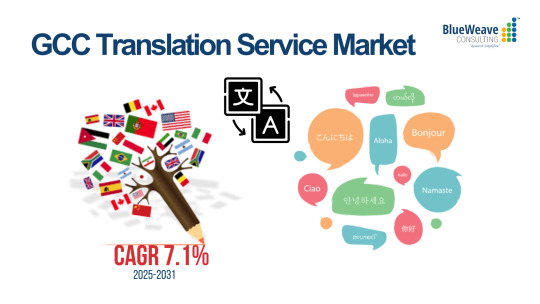
GCC Translation Service Market size by value at USD 2.1 billion in 2024. During the forecast period between 2025 and 2031, BlueWeave expects GCC Translation Service Market size to boom at a robust CAGR of 7.1% reaching a value of USD 3 billion by 2031. The growth of Translation Service Market across GCC countries (Bahrain, Kuwait, Oman, Qatar, Saudi Arabia, and UAE) is propelled by an increasing focus on economic diversification and digital transformation. The demand for translation services increases with the integration of human expertise, advanced machine translation technologies, and the growing use of cloud-based models. Key stakeholders like government agencies, corporations, SMEs, healthcare providers, legal firms, and the tourism sector recognize the importance of accurate, culturally nuanced translations for regulatory compliance and engaging multilingual audiences. The rise of cloud-based Translation Management Systems (TMS) and Software-as-a-Service (SaaS) facilitates cross-border collaborations and real-time project management, aligning with smart city initiatives like Saudi Arabia's NEOM. Cloud adoption grew from 45% in 2020 to over 60% in 2023, enabling businesses to manage content efficiently, driving market growth.
Sample Request: https://www.blueweaveconsulting.com/report/gcc-translation-service-market/report-sample
Opportunity - Advancements in AI-driven Translation Technologies Offering Real-Time Language Solutions
Advancements in AI-driven translation technologies are emerging as a significant growth opportunity for the GCC Translation Service Market. The rapid development of artificial intelligence is enabling businesses in the region to adopt AI-powered solutions for real-time language translation, enhancing both speed and accuracy while facilitating seamless communication across diverse linguistic and cultural landscapes. This is especially crucial in the GCC’s multilingual environment, where sectors such as legal, healthcare, education, and finance rely on precise, timely communication. AI-driven tools are revolutionizing these industries by bridging language gaps efficiently, improving translation quality, and preserving cultural nuances. Additionally, the GCC's growing role as a global business hub, with its diverse expatriate population and expanding multinational presence, further emphasizes the need for scalable, real-time translation services. AI technologies meet this demand by offering faster, more cost-effective solutions, reducing reliance on traditional, time-consuming methods. These innovations align with the GCC’s broader goals of digital transformation and innovation, with governments and businesses actively investing in tools that improve operational efficiency. As international expansion continues to be a focus for businesses in the region, the integration of AI into translation services is set to drive market growth, offering real-time, accurate, and culturally relevant language solutions.
#BlueWeave#Consulting#Marketforecast#Marketresearch#LanguageSolutions#TranslationTechnology#DigitalTransformation#Translation#Interpretation#LanguageServicesProvider
0 notes
Text
How to Improve the Accuracy of OCR Translation Tools?

Optical Character Recognition (OCR) technology got better and better over the past decade thanks to more elaborated algorithms, more CPU power,r, and advanced machine learning methods. Getting to OCR translation accuracy levels of 99% or higher is however still rather the exception and definitely not trivial to achieve.
We learned at Devnagri AI the hard way how to fine-tune our OCR engine to achieve good OCR accuracy and spent weeks fine-tuning our Image to Text Converter Online engine. So, if you are in the process of setting up an OCR solution and want to know how to increase the accuracy levels of your OCR engine, then keep on reading…
This blog talks about various techniques to enhance OCR accuracy and shares what we learn from building a world-class OCR system for Devnagri AI.
So, First, Let's Define OCR Translation Accuracy
Now when talking about OCR accuracy, there are two ways of measuring how reliable OCR is:
Accuracy on a character level: In most cases, the accuracy in OCR technology is gauged on a character level. The extent to which an OCR software is accurate on a character level is determined by how often it recognizes a character correctly and how often it recognizes a character incorrectly. A 99% accuracy means that 1 out of every 100 characters is uncertain. However, an accuracy of 99.9% means that 1 out of every 1000 characters is uncertain.
Accuracy on a word level: Most OCR translation engines use extra language knowledge about text to enhance their word-level accuracy. That is if the language is known where the text, for instance, is the English language, words recognized can then be compared to the dictionary of all extant words-for example, to all words in an English language corpus. Words containing uncertain characters can then be "fixed" by finding the word inside the dictionary with the highest similarity.
In this blog, we will focus on improving the accuracy of character level. The more accurate characters are recognized, the less "fixing" on a word level is required.
How to Increase Accuracy With OCR Translation Image Processing?
Assuming that you have already settled on an Image to Text Converter Online engine, we're now down to one single moving part in the equation to improve the accuracy of OCR:
Good Quality Original Source
Yes, we're repeating this on purpose! The very first simple step in obtaining precise OCR translation conversions is guaranteeing the good quality of the source images. First off, see that the original paper document does not contain tears, creases, or fading or was printed in poor contrasting color ink. In that case, outputting won't be clear enough. Use therefore the cleanest and the most original source of the file to convert.
Scaling To The Right Size
Make sure the images are at the appropriate resolution and are usually of at least 300 DPI (Dots Per Inch). Lowering DPI below 200 results in blurry and unclear images. A higher DPI of above 600 unnecessarily inflates the output file size but fails to improve the quality of the file. Therefore, 300 DPI is appropriate in this regard.
Increase Contrast
Low contrast can lead to poor OCR Translation. Increase the contrast and density before scanning. This can be done directly in the scanning software or any other image-processing software. Increasing the contrast of the text/image with its background brings out more clarity in the output.
Binarize Image
This is a step that converts a multicolored image (RGB) into a black-and-white image. There are several algorithms for converting a color image to a monochrome image, ranging from simple thresholding to more sophisticated zonal analysis.
What We Learned From Building The Devnagri AI OCR Pipeline?
When there is one thing learned about OCR accuracy, there is no silver bullet, and nothing is easier when it comes to shortcutting Image to Text Converter Online performance. You must inspect the documents carefully before attempting anything. Once you know your shortfalls, you can proceed to the applications of preprocessing steps as aforementioned to improve the accuracy of your OCR translation.
It is key to understanding how preprocessing works to tailor a preprocessing pipeline for the documents that you want to process. That's why we wanted to expose all preprocessing options to our users in Devnagri AI. Our default settings actually work well for most cases, but every preprocessing step can be tweaked according to the type of document that a user wants to process.
#OCRTranslation#OCRAccuracy#TranslationTechnology#AIinTranslation#LanguageRecognition#MachineLearning#TextRecognition#TranslationTools#OCROptimization#LanguageAI
0 notes
Text
Azure AI Translate everything you need to know

Struggling to manage multilingual communication in your organization? Discover how Azure AI Translator can revolutionize your IT operations and bridge the language gap effortlessly. This cloud-based service supports 90+ languages, offering real-time text and document translations with advanced neural machine translation technology.
Why Read This Blog?
Seamless integration with your IT systems
Easy-to-use REST API for instant scalability
Cost-effective solutions with up to 2 million free characters per month
Enhance global collaboration and efficiency
Learn how Azure AI Translator can power up your global operations.
Read Now: https://www.ecfdata.com/azure-ai-translate-everything-you-need-to-know/
#AzureAI#TranslationTechnology#GlobalIT#NeuralMachineTranslation#azure ai#azure ai services#azure ai ml#ai azure#azure ai pricing#azure ai vision#ai in azure#azure ai search#azure openai
1 note
·
View note
Text
The Future of Simultaneous Interpreting Services: AI vs. Human Interpreters
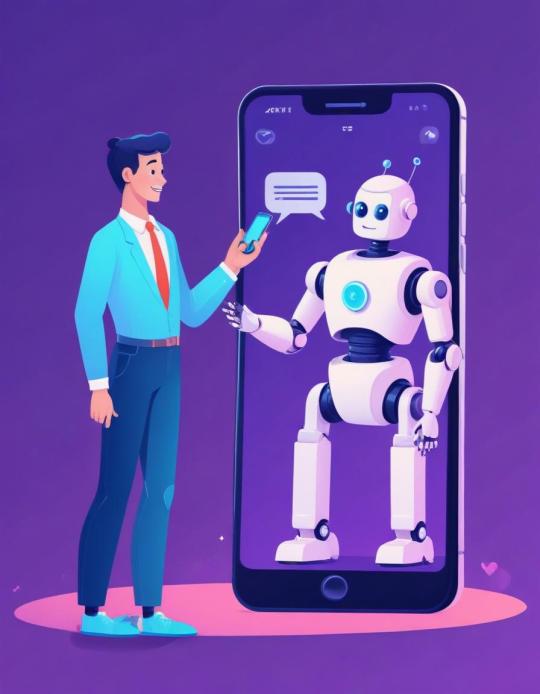
The landscape of simultaneous interpreting services is undergoing a significant transformation, driven by advancements in artificial intelligence (AI). Recently, a Tokyo-based public research institute under the Internal Affairs and Communications Ministry developed an AI capable of simultaneous interpretation with a natural conversational flow. Created by the National Institute of Information and Communications Technology (NICT), this AI is set to be deployed at the 2025 Osaka-Kansai Expo and is expected to be used in international negotiations by 2030. But how does AI stack up against human interpreters in this critical field? This article explores the comparison between AI and human interpreters, focusing on accuracy, tone and nuance, potential displacement of human interpreters, and the future trends of the industry.
Accuracy: The Core of Interpretation
Accuracy is very important in simultaneous interpretation, where the goal is to convey a speaker’s message with as little distortion as possible. Human interpreters have long been the gold standard, drawing upon their deep understanding of language, culture, and context to deliver precise translations. However, even the best interpreters can struggle under the immense pressure of real-time translation, occasionally leading to minor inaccuracies or omissions.
AI interpreters, on the other hand, benefit from vast databases of linguistic data and specialized glossaries, enabling them to deliver highly accurate translations. The AI developed by NICT, for example, was trained with the assistance of seasoned interpreters and can perform bidirectional interpretation in multiple languages, including Japanese, English, Chinese, Korean, and French. However, AI’s accuracy can still be limited by its programming, especially in complex or ambiguous contexts where cultural knowledge and human intuition are essential.
Tone and Nuance: The Human Element
One of the most significant challenges for AI in simultaneous interpreting is capturing the subtlety of tone and nuance. Human interpreters excel in this area, as they can understand the emotional undertones and cultural context behind words, adjusting their interpretation to reflect the speaker's intent accurately. This ability is crucial in diplomatic or high-stakes negotiations, where a slight misinterpretation could lead to misunderstandings or conflict.
AI, despite its advancements, still struggles to consistently interpret tone and nuance correctly. While it can recognize and replicate certain speech patterns, it often lacks the cultural and emotional intelligence that human interpreters bring to the table. For now, this remains a critical limitation of AI in the field of simultaneous interpretation.
Will AI Replace Human Interpreters Entirely?
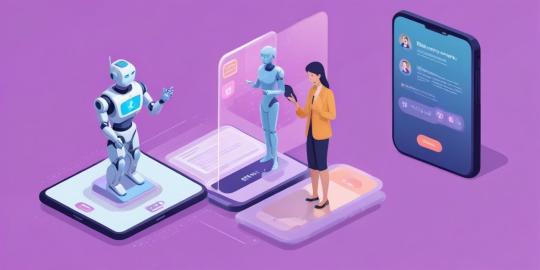
The question of whether AI will eventually replace human interpreters is a topic of ongoing debate. AI’s rapid development suggests that it could handle a growing number of interpreting tasks, particularly in environments where speed and efficiency are prioritized over nuanced communication. In settings like large conferences or routine business meetings, AI interpreters may become the preferred choice due to their ability to process information quickly and consistently.
However, in situations where the stakes are high, and the need for cultural sensitivity is paramount, human interpreters are likely to remain indispensable. The subtle art of interpreting goes beyond word-for-word translation, requiring a deep understanding of context, tone, and intent—qualities that AI has yet to master fully.
Adapting to the Future: How Human Interpreters Can Thrive
As AI continues to evolve, human interpreters will need to adapt to maintain their relevance in the industry. This could involve working alongside AI to handle the more routine aspects of interpretation while focusing on the areas where human expertise is most needed. Interpreters may also need to develop specialized skills in interpreting complex and culturally sensitive material, positioning themselves as experts in areas where AI still falls short.
Moreover, ongoing professional development will be crucial. By staying up-to-date with technological advancements and continuously refining their linguistic and cultural knowledge, human interpreters can ensure they remain competitive in a rapidly changing field.
The Pros and Cons of AI in Simultaneous Interpreting
Pros:
Efficiency: AI can process and translate information quickly, making it ideal for fast-paced environments.
Consistency: AI provides consistent translations, free from the fatigue or stress that can affect human interpreters.
Scalability: AI can be deployed across multiple languages and regions simultaneously, offering broad accessibility.
Cons:
Lack of Cultural Sensitivity: AI often struggles with the nuanced understanding of cultural context and emotional tone.
Dependence on Data: AI's accuracy is heavily reliant on the quality and scope of its training data, which may not cover all linguistic subtleties.
Limited Adaptability: AI can struggle in unpredictable or highly complex situations where human intuition is required.
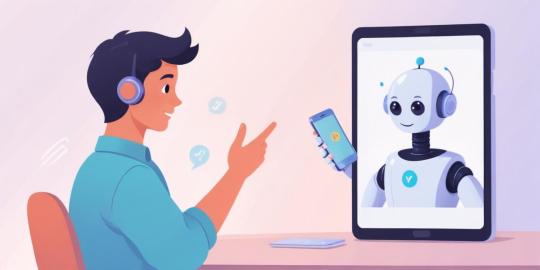
Future Trends: The Path Ahead
Looking ahead, the future of simultaneous interpreting services is likely to be a hybrid model where AI and human interpreters work together. AI will handle the bulk of straightforward translations, while human interpreters will be called upon for more intricate tasks that require a deep understanding of cultural context and emotional nuance. This collaboration could lead to more efficient and accurate interpretation services overall, combining the strengths of both AI and human expertise.
Additionally, as AI technology continues to improve, we may see the development of more sophisticated systems capable of better understanding and replicating human-like interpretation. This could further blur the lines between AI and human interpreters, creating a dynamic and evolving industry.
In conclusion, while AI is poised to play an increasingly important role in simultaneous interpreting services, human interpreters are far from obsolete. By embracing the opportunities presented by AI and focusing on areas where human skills are irreplaceable, interpreters can continue to thrive in a rapidly changing world.
#SimultaneousInterpreting#AIInterpreters#HumanInterpreters#InterpretingServices#AIvsHuman#TranslationTechnology#InterpretationAccuracy#LanguageServices#FutureOfInterpreting#AIInTranslation#CulturalSensitivity#MachineLearning#InterpreterSkills#LanguageAI#GlobalCommunication#AIInnovation#TechInLanguage#InterpreterLife#ConferenceInterpreting#MultilingualAI#TechAndHumanCollaboration#InterpretingFuture#AITranslation#NuanceInInterpreting#AIInConferences
0 notes
Text
Rewolucja w branży tłumaczeń: Narzędzia CAT jako klucz do przyszłości
W dzisiejszym dynamicznie rozwijającym się świecie technologii, narzędzia CAT (Computer-Assisted Translation) stanowią fundament nowoczesnego tłumaczenia, zapewniając profesjonalistom nie tylko wsparcie w codziennej pracy, ale również gwarantując wyższą jakość i spójność przekładów. Biuro Tłumaczeń Advance, lider w wykorzystaniu innowacyjnych rozwiązań w branży tłumaczeniowej, przedstawia wnikliwe spojrzenie na to, jak narzędzia CAT zmieniają oblicze tłumaczeń. Artykuł rzuca światło na różnorodność dostępnych narzędzi, ich funkcjonalności oraz korzyści płynące z ich zastosowania, zarówno dla tłumaczy, jak i klientów potrzebujących precyzyjnych tłumaczeń. Od pamięci tłumaczeniowej, przez terminologie, aż po zintegrowane systemy zarządzania projektami, narzędzia CAT są nie tylko przyszłością, ale już teraźniejszością w branży tłumaczeń. Zapraszamy do lektury pełnego artykułu, aby dowiedzieć się więcej o tym, jak Biuro Tłumaczeń Advance wykorzystuje te technologie do świadczenia usług na najwyższym poziomie. Czytaj więcej.

#NarzędziaCAT#TłumaczeniaProfesjonalne#Technologia#Innowacje#BiuroTłumaczeńAdvance#JakośćTłumaczeń#CATTools#TranslationTechnology#ProfessionalTranslators#AdvanceTranslationOffice#tłumacz#tłumaczenia#tłumaczprzysięgły#biurotłumaczeń
0 notes
Text

How to use AI in translations wisely?
Read more at our LinkedIn
#TranslationTechnology hashtag#AILanguage hashtag#GlobalCommunication hashtag#TranslationServices hashtag#TechInnovation hashtag#AIinBusiness hashtag#Linguistics hashtag#ProfessionalTranslation hashtag#MachineLearning hashtag#ArtificialIntelligence#translation agency
0 notes
Text
🚨 Stop Believing the AI Hype, that’s the title of my latest conversation on the Localization Fireside Chat with none other than @Dr. Sidney Shapiro, Assistant Professor at the @Dillon School of Business, University of Lethbridge. We dive deep into what AI can actually do, and more importantly, what it can’t. From vibe coders and synthetic data to the real-world consequences of over-trusting black-box models, this episode is packed with insights for anyone navigating the fast-moving AI space. 🧠 Dr. Shapiro brings an academic lens and real-world practicality to an often-hyped conversation. If you're building, deploying, or just curious about AI, this is a must-read. 🎥 catch the full interview on YouTube: 👉 https://youtu.be/wsqN0964neM Would love your thoughts, are we putting too much faith in AI? #LocalizationFiresideChat #AIethics #DataScience #AIstrategy #GenerativeAI #MachineLearning #CanadianTech #HigherEd #Localization #TranslationTechnology #Podcast
#AI and Academia#AI Ethics#AI for Business#AI Hype#AI in Canada#AI Myths#AI Strategy#Artificial Intelligence#Canadian Podcast#Canadian Tech#chatgpt#Data Analytics#Data Science#Dr. Sidney Shapiro#Explainable AI#Future of AI#Generative AI#Localization Fireside Chat#Machine Learning#Robin Ayoub#Synthetic Data#Technology Trends
0 notes
Text
Translation technology usage in translation courses in universities

Translation technology usage in translation courses in universities
If you were born in the 80’s or the 90’s, you’d very well remember that every subject was limited to theoretical practices, commonly known as books. Even the researchers head to the libraries for taking notes. There were surely other ways such as study tours, special classes, activities and group assignments but there was never even the hint of using technology in the sphere of the education. The only perspective common people had in their minds about technology was that it could make appliances better. Cool new gadgets could be called in-fashion and people would consider them as a technological innovation but that was it. Today, even young students are taught with the help of tools such as projectors, tabs and computers. Technology is now too deep-rooted in our lives that we can’t even imagine living without it. Educational courses are now strongly connected with the very core of IT. Take translation technology courses, diplomas and degrees for instance, most people consider them purely as a medium which can be studied exclusively through traditional ways. However, today universities all across the globe have revived their policies on teaching language courses without incorporating the latest technology into the study material and practices.
MACHINE TRANSLATION, THE GENERAL USAGE
Machine translations from the perspective of a customer are just an easy piece of work. They believe that when a company or a professional uses machine assistance for a project, they are actually defying the purpose of hiring them in the first place. But that’s not the case. Large volume texts are sometimes impossible to translate in a manual way. Moreover, sometimes there are documents and files with recurring texts, words and terminologies and using machine assistance becomes inevitable.
CAT TOOLS; Incorporated Learning
Recently, universities have started teaching language courses along with CAT Tools or Computer Aided Translation technology tools. Students are trained to use these tools while working with large texts with more efficiency. Using computers as a part of their courses is not just to save time and effort but also because it’s impossible for students to choose a career without computer application. CAT comprises four basic elements,
Segmentation
The first and foremost function is dividing the text into segments, making it easier to translate. Each segment is placed in a box and the translation is entered under the source box. This way, time and effort of going through the whole text is saved and work is done quicker than the usual process.
TU (Translation Unit)
Each of the segment, along with the source text box, is saved as a TU or translation unit. With the help of CAT tools, students can navigate their way to these units at any time and utilize the same text again and again according to their requirement.
TM (Translation Memory)
This is said to be the most essential part of CAT tools, preserving the translation memory into the database for later use. A special feature known as the FUZZY Search allows users to even cross check the segments which don’t match 100% with the required search.
Terminology Databases
The fourth function that can be accessed by CAT Tools is looking for the terminologies by inserting them through relevant search items. CAT Tools have thus become a crucial part of almost every translation course at the world’ leading universities. In fact, these tools allow users to utilize automated features even with the projects that have been done manually.
CAT Tools Utility Out Of Machine Translations
Quality checking can also be done through specific features of these tools. They cross match the translated text with the rules and regulations of international quality standards. Students can enter search items and find their required meanings even when they are doing a project without really using the machine. Along with that, they can search for the correct formatting for a certain document or certificate. They can connect to the internet and find a relative terminology that they are looking for. Resulted texts can also be aligned using these tools.
Do All Universities Use Translation Technology In Their Courses?
Well, as a matter of fact, there are still hundreds and thousands of universities, which are still considering to make IT an integral part of their translation courses, yet they are still using the conventional methods of teaching so far. In a professional way, however, linguists and professors of dozens of universities in the US, suggest the use of CAT tools in language courses. They assert that these can help the students in doing their work in an efficient manner. Of course, they don’t need a machine or software assistance while translating a certificate yet when it comes to the documents with hundreds of pages, they must be trained to use CAT tools as a part of their qualification. Furthermore, these tools are meant to support the language service industry on a much bigger level than just one dimension, thereby, using them only adds to the value and nothing else. If you are thinking about choosing a language interpretation course, do check out what the university policy is, about the use of technology in the field of interpreting languages into one another. Read the full article
0 notes
Text
Rise of AI into Machine Translation API redefining the Translation Industry
Understanding the new era of artificial intelligence backed by machine learning is complicated. Machine translation is also on the trend utilizing the latest technologies available out there. Companies specifically large enterprises and SMBs are using machine translation API ensuring high accuracy and scalable content. Even government organizations in the management and security as well are into a lot of translation.
At the pace at which AI is developing, we can look at the future easily. Even the news is older about training neural networks on computers to store information and make it available customized and filtered as per requirement. These networks are backed by generative AI but still make mistakes because these networks still cannot be analyzed at a certain human level.
Still, large organizations are processing their operations with a combination of artificial and human-based intelligence. Undeniably, our machine can not start thinking like human beings suddenly but these tools are still on the training model.
Now if we talk about the translation industry, Machine Translation APIs come into the game where these tools use the generative API and are on tegular training backed by machine learning as discussed in the introduction at the beginning of this blog.
Now what’s new with machine translation APIs during the rise of AI in the market
Size Matters
Now size also matters with an increase in requirements of the translation content in sort of types including the visuals, audios, and videos as well apart from the text. Organizations are translating the contexts not only into official or most popular languages.
Also, the local dialects to localize their content as well as the business. Training and manipulating the data is part of training models which is important to build a database empowering the robust functionalities into the machine translation API.
Speed is Everything
Now speed is everything in this fast-forward era, here people compete on speed. No one has time, technology is moving forward at a pace that couldn’t have been imagined a few decades back. Every day is something new out there in terms of content in the market.
Now Generative AI tools in the market whether they are paid or free, no one has a monopoly in the market they all are facing competition. Every giant across the globe has its own AI for the users.
Changes to The Translation Industry
The question arises that the whole will think about the business looking to localize their business in the market.
Who is sitting to customize the services for their business according to the use case? Also, the people residing deep in the different regions of the world almost everyone is using the internet but everyone is not contributing to it.
Moreover, most of the content is in English over the content. How the local people will access that content until and unless they know the international English Language?
Summing Up
Far from the large language models here comes the small language models and machine translation APIs that support the website translation and app translation in terms of multiple languages helping the companies to reach their users and distribute their services at a vast level.
Not only the product and service market but also the market that supports education, hospitality, banking, business, government, security, e-commerce, and media. Keep reading for more.
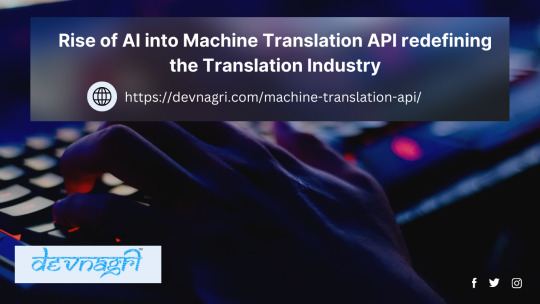
#AITranslation#MachineTranslation#AIinTranslation#TranslationTechnology#LanguageAI#TranslationInnovation#FutureOfTranslation#AIRevolution#TechInTranslation#SmartTranslation
0 notes